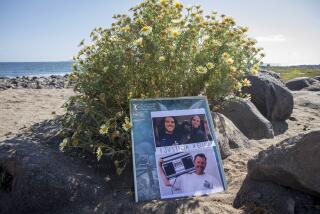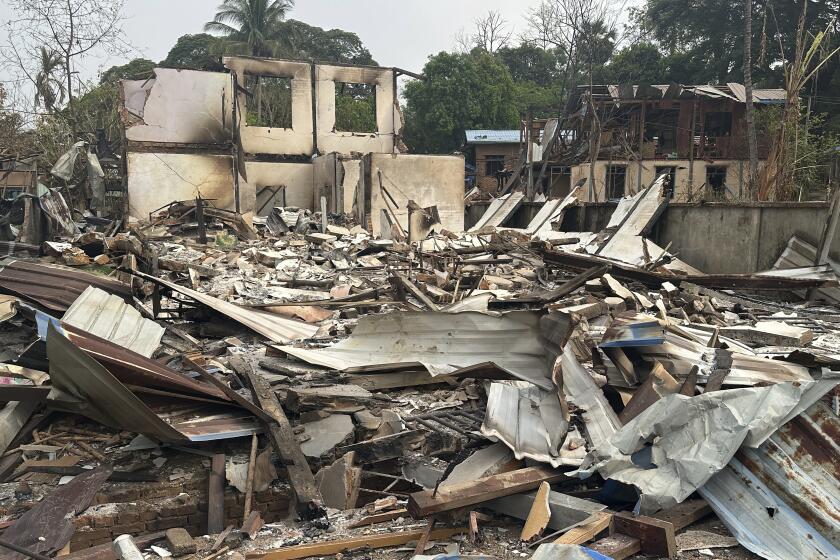Environment : Manila--A City Out of Control : The rivers are dead. The air is solid. And in one of the world’s fastest-growing cities, the garbage seems to be growing even faster.
Early explorers named this city after the green may-nilad plants that graced the gently flowing Pasig River, and the country’s 19th-Century Spanish rulers naturally built their Malacanang Palace along the Pasig’s placid banks.
Today, scientists say the Pasig and every other river in Manila are biologically dead. Garbage, raw sewage and industrial waste wash up against Malacanang’s white walls and grim squatters’ shacks alike. A fetid stench sours the air.
“Sometimes I get sick,” concedes Hector Aldomo, who holds his nose as he collects fares on the newly inaugurated Pasig River ferry. “The smell is very bad.”
That’s not surprising. Once known as the “pearl of the Orient,” this sprawling capital of 8 million is now “one of the more polluted urban areas in the world,” according to a recent Asian Development Bank report.
As elsewhere in the Third World, Manila’s environmental troubles are a result of rocketing population, grinding poverty, unregulated industry and poor planning. Here they have combined to create virtually uncontrolled air, water and ground pollution in one of the world’s fastest-growing cities.
Most of Manila was leveled in World War II--by some estimates, only Warsaw was left more ravaged--but the city still relies on a crumbling prewar infrastructure, including its water mains and sewers. And up to 40% of the residents live in squalid slums with no running water or sewers.
Overburdened and under-funded, President Corazon Aquino’s four-year-old government has only begun to address the city’s ills. Take air pollution, for example.
“Manila’s getting up like Mexico City as far as air quality standards,” an American environmental expert said as a yellow, smoky pall filled the sky outside his 17th-floor office. “It’s one of the world’s worst.”
“I wouldn’t know,” responded Fulgencio S. Factoran Jr., secretary of the Department of Environment and Natural Resources, “because we don’t have any equipment to tell us how bad it is.”
The city’s air-monitoring equipment, donated in 1974, broke down several years later and was abandoned in 1985. It was never replaced. Nor does the city have equipment to monitor the giant smokestacks through which power plants and factories pump black soot and heavy metals into the air each day.
The worst offenders, officials say, are the city’s 511,000 registered vehicles. Most, particularly trucks and buses, use aging diesel engines imported from Japan after they could no longer meet emission standards there. Their fuel has among the highest sulfur and lead content in the world.
As a result, more than half of Manila’s vehicles would fail an emissions test, according to Butch Dayrit, head of a new citywide campaign to curb “smoke-belchers.” He estimates that they are responsible for 70% of the air pollution.
“But we really don’t know because there are no emissions tests,” Dayrit added.
Instead, the city fielded one five-man team for more than a decade to watch cars, trucks and buses pass on the street. They stopped any with noticeably dirty exhaust. In 1988, they ticketed 2,436 vehicles. Records show that most drivers simply threw the tickets away.
Since last year, a joint government and private campaign--called GAS MASC, for the Group Against Smoke-Belching to Make Air Safe and Clean--has dispatched 10 teams a day. In the first four months of this year, they stopped more than 16,000 vehicles.
Instead of just writing tickets, the teams cut license plates off offending vehicles. The owner must repair the engine or pay a fine to get the plate returned. If he’s caught again, the fine increases.
On a recent morning, two teams pulled over scores of taxis, trucks and “jeepneys”--the elongated jeeps used for public transportation--on Quirino Avenue in southern Manila. In two hours, they had taken 40 license plates, mostly from vehicles that pumped out thick, black, noxious clouds of exhaust.
It is a valiant effort, but Dayrit acknowledges that it may be futile without public education, the use of unleaded gas and a ban on “clunker” engine imports.
“We don’t know if it makes a difference,” he said of his smoke-belcher program. “Our object is to improve the air by 50%. But 50% of what? We don’t know.”
In contrast, officials do know how sick Manila’s six rivers are.
“There’s no living organisms left in the rivers,” says Celso R. Roque, undersecretary of environment and research. “They’re biologically dead.”
The chief problem is that only 12% of Manila’s homes are connected to sewers. Most of the rest use leaking septic tanks or storm drains. As a result, said Roque, “all the waste from residential communities winds up in the rivers.”
So does waste from hundreds of factories, including paper mills, breweries and steel mills. Despite improvements, the government estimates that only one-fourth of the nation’s 1,500 industries comply with water pollution standards.
A 45-minute ferry ride down the Pasig is a stomach-churning experience. Garbage floats almost everywhere. Sunken barges leak oil. Milky liquids pour from open pipes. The stench of raw sewage is overpowering.
And although swimming is obviously unsafe, two groups of naked boys were seen diving and swimming in the Pasig’s septic ooze. Elsewhere, men bathed themselves off a grounded tugboat, and women washed clothes under bridges and along the crumbling concrete berms. Thousands of tin-roofed squatters’ shacks line the river’s edge.
Manila’s other rivers are no better. When a U.S. Environmental Protection Agency official inspected the Tullahan last year, Factoran recalled, “he got sick and puked all day.”
One reason is garbage. Metropolitan Manila produces an estimated 3,400 tons of solid waste each day, but less than half is collected and hauled to dump sites. The rest, about 1,900 tons, is either left on streets, burned or dumped in canals and rivers.
The garbage will only grow as Manila’s population zooms. But the city’s seven open dump sites are filled to capacity, and experts have repeatedly recommended that they be closed as unsafe. Plans to do so have foundered, not least because thousands of scavengers, with nowhere else to go, literally live off the dumps.
The largest and most infamous is Smokey Mountain, a giant, festering garbage dump in the Tondo area of north Manila. At least 12,000 people live in ramshackle shanties, digging through stinking refuse for usable items.
Not surprisingly, Smokey Mountain residents suffer the nation’s highest death rates, according to a report last year by the Swiss Tropical Institute. Nearly every child was found to have intestinal parasites, and two-thirds of the infants suffered from malnutrition.
Most environmental laws are openly evaded or ignored, according to the Asian Development Bank study. And there is no law at all to deal with toxic and hazardous waste from chemical, fertilizer and pharmaceutical firms.
“Much of the waste is just buried, so the problem is in the future,” said Angelina Galang, vice president of the Haribon Foundation, a conservation group.
The government has ambitious plans to revive the rivers and close Smokey Mountain. But a long-planned sewer improvement program was indefinitely deferred in favor of repairs to the water-supply system. Other proposals also have been shelved.
“They recognize most of the problems,” said a consultant for the U.S. Agency for International Development. “But they lack the resources to do something tangible.”
Perhaps the crisis was captured best on Earth Day, April 22, when communities around the world met to show concern for the environment. In Tagaytay City, south of Manila, 16-year-old Jerwin Javier mounted the stage as Mother Nature and lit a torch to show her power.
Suddenly, a strong wind blew the flames onto her dress. Screaming, she rolled onto the canvas stage, suffering minor burns on her arms and back.
“She was lucky,” said Roque. “But I think it was very symbolic.”
More to Read
Start your day right
Sign up for Essential California for news, features and recommendations from the L.A. Times and beyond in your inbox six days a week.
You may occasionally receive promotional content from the Los Angeles Times.







